Kyrenia is the name of a town and small harbor on the north coast of Cyprus (indicated by the pin on the map).
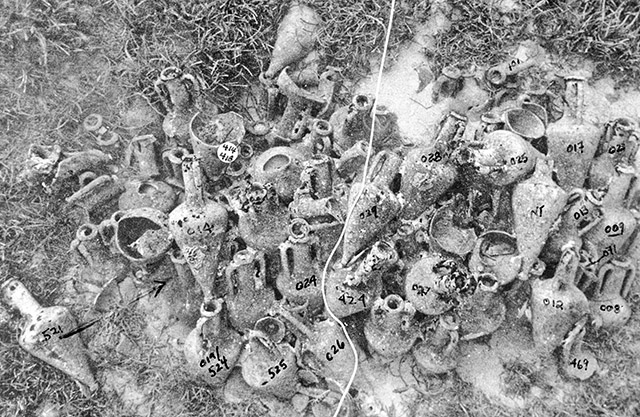 In 1965, while hunting for sponges at a depth of 30m about 1km off shore, local diver Andreas Cariolou came across a pile of ancient amphoras (they protruded from the surrounding eel grass much like the cleaned pile at the left; photo courtesy of Susan Katzev; hover over to enlarge). Turned out that this mound of artifacts marked the resting place of an ancient Greek merchant ship that sank in the 4th century BCE.
In 1965, while hunting for sponges at a depth of 30m about 1km off shore, local diver Andreas Cariolou came across a pile of ancient amphoras (they protruded from the surrounding eel grass much like the cleaned pile at the left; photo courtesy of Susan Katzev; hover over to enlarge). Turned out that this mound of artifacts marked the resting place of an ancient Greek merchant ship that sank in the 4th century BCE.
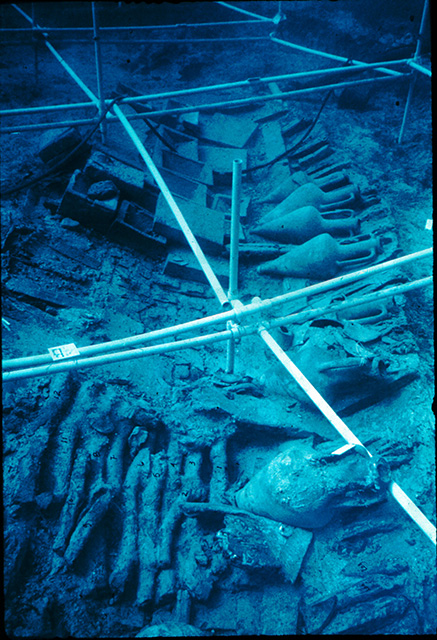 The site was surveyed and then excavated by a team from the University of Pennsylvania under the direction of Michael Katzev, from 1967-1969 (see a photo of the cleared site at the left; image courtesy of Susan Katzev; hover over to enlarge). Eventually, the wreck site yielded nearly 400 (mostly Samian and Rhodian) amphoras, nearly 30 grain millstones, coins, anchors, iron blooms, stone ballast, rope, tools, and various other pots and cooking utensils. Among the pots were found over 10,000 almonds, 18 olive pits, 760 grape seeds, over 10,000 fig seeds, and more--an amazingly huge amount of retrievable items.
The site was surveyed and then excavated by a team from the University of Pennsylvania under the direction of Michael Katzev, from 1967-1969 (see a photo of the cleared site at the left; image courtesy of Susan Katzev; hover over to enlarge). Eventually, the wreck site yielded nearly 400 (mostly Samian and Rhodian) amphoras, nearly 30 grain millstones, coins, anchors, iron blooms, stone ballast, rope, tools, and various other pots and cooking utensils. Among the pots were found over 10,000 almonds, 18 olive pits, 760 grape seeds, over 10,000 fig seeds, and more--an amazingly huge amount of retrievable items.
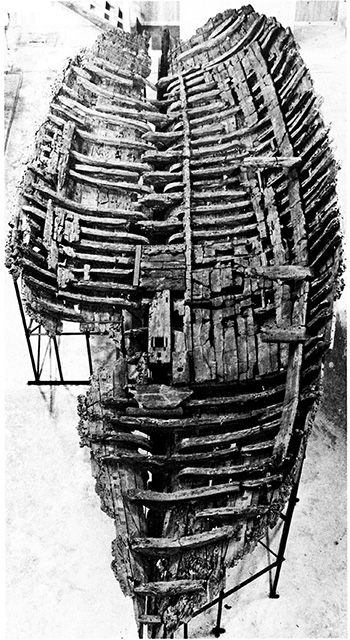 The surviving timbers and wood features of the wreck, unusual in their extent, were slowly excavated and raised. The wood was treated for preservation and conservation in special tanks from 1971 until 1973, when the remains were extensively studied (under the expert eye of the late J. Richard Steffy) in order to build a sailable replica and mount the wreck in the Kyrenia castle museum, along with many of the artifacts (see a photo of the restoration in the museum at the left; image courtesy of Susan Katzev; hover over to enlarge).
The surviving timbers and wood features of the wreck, unusual in their extent, were slowly excavated and raised. The wood was treated for preservation and conservation in special tanks from 1971 until 1973, when the remains were extensively studied (under the expert eye of the late J. Richard Steffy) in order to build a sailable replica and mount the wreck in the Kyrenia castle museum, along with many of the artifacts (see a photo of the restoration in the museum at the left; image courtesy of Susan Katzev; hover over to enlarge).
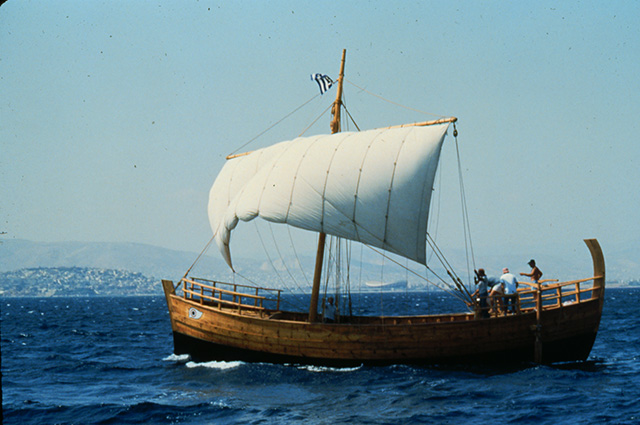 The Kyrenia II replica sailed under its own power in 1985 (see a view of the replica at the left; photo courtesy of Susan Katzev; hover over to enlarge). It seems likely that the original ship carried a crew of 4 (based on the sets of 4 personal utensils and pots found together in the ship’s hold). The vessel was likely plying the waters between Samos, Rhodes, and Cyprus for a long time before it sank, for reasons that are still not entirely clear (e.g, was it piracy or simply old age?).
The Kyrenia II replica sailed under its own power in 1985 (see a view of the replica at the left; photo courtesy of Susan Katzev; hover over to enlarge). It seems likely that the original ship carried a crew of 4 (based on the sets of 4 personal utensils and pots found together in the ship’s hold). The vessel was likely plying the waters between Samos, Rhodes, and Cyprus for a long time before it sank, for reasons that are still not entirely clear (e.g, was it piracy or simply old age?).
Most so-called amphora wrecks are just that, shipwreck sites marked by piles of ancient transport pottery, but containing little or no evidence of the ship that carried them. Kyrenia is thus very unusual since so much of its cargo remained still nicely dispersed amongst so many surviving timbers. After many years of analyzing the cargo, crew’s belongings, and ship’s timbers, composing the final publication of the Kyrenia wreck began under the supervision of Susan Katzev and her colleagues. Despite the long time spent studying all the evidence, fundamental questions and problems remained. These questions could not adequately be answered, they reasoned, by traditional archaeological interpretive or visualization methods.
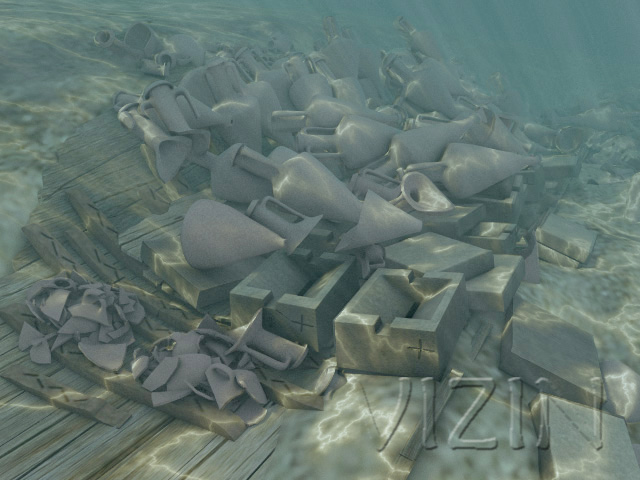 Beginning in 2004, Learning Sites provided its expertise to the Institute for the Visualization of History, which was contracted by the Kyrenia team, to help visualize the wreck site and its contents and provide innovative interactive means for studying the cargo, test hypotheses about the ship, and gather material for a digital publication (see a rendering from our 3D model of the wreck site at the left; hover over to enlarge). The basic tasks were:
Beginning in 2004, Learning Sites provided its expertise to the Institute for the Visualization of History, which was contracted by the Kyrenia team, to help visualize the wreck site and its contents and provide innovative interactive means for studying the cargo, test hypotheses about the ship, and gather material for a digital publication (see a rendering from our 3D model of the wreck site at the left; hover over to enlarge). The basic tasks were:
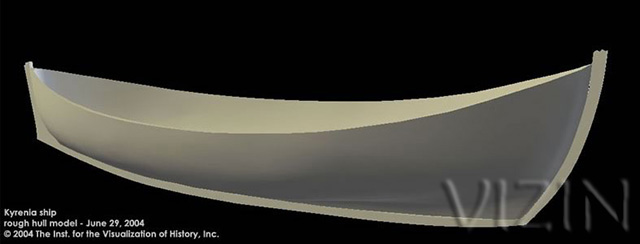 The project began with 3D computer models of the hull (see the massing study at the left, based on lines drawings compiled by Steffy; hover over to enlarge) and then some of the typical and also the more unusual objects recovered. Since the ship seems to have undergone numerous repairs over its lifetime, the Kyrenia team decided that our team should work from the existing remains and extrapolate from those to the final design of the vessel (not its very first original form). We are lucky enough to be working, for the ship’s details, under the guidance of (the late) J. Richard Steffy, who worked in Cyprus on the wooden remains of the ship during the 1970s; and for the artifacts and overall project vision, directly with the excavator, Susan Katzev.
The project began with 3D computer models of the hull (see the massing study at the left, based on lines drawings compiled by Steffy; hover over to enlarge) and then some of the typical and also the more unusual objects recovered. Since the ship seems to have undergone numerous repairs over its lifetime, the Kyrenia team decided that our team should work from the existing remains and extrapolate from those to the final design of the vessel (not its very first original form). We are lucky enough to be working, for the ship’s details, under the guidance of (the late) J. Richard Steffy, who worked in Cyprus on the wooden remains of the ship during the 1970s; and for the artifacts and overall project vision, directly with the excavator, Susan Katzev.
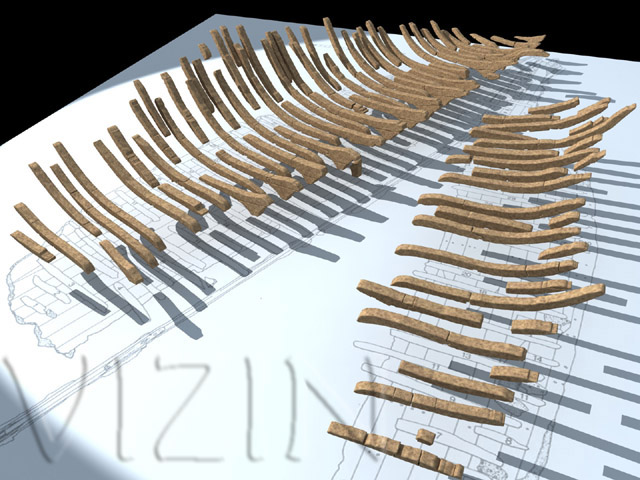 Creating the frames (at the left; hover over to enlarge) over the detail drawings and with use of section drawings by Steffy
Creating the frames (at the left; hover over to enlarge) over the detail drawings and with use of section drawings by Steffy
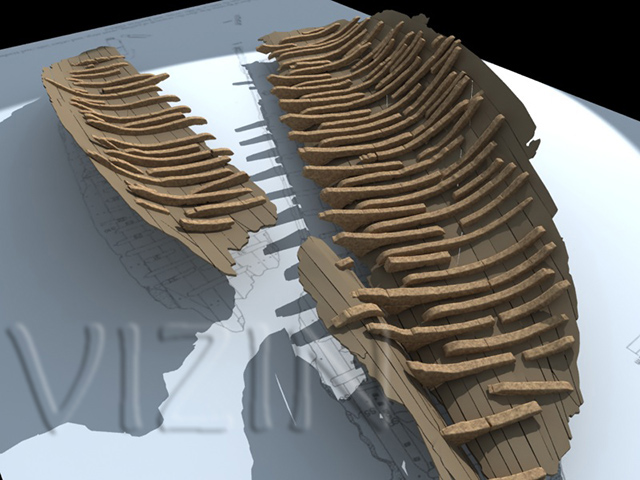 Adding the planks of the as-excavated hull to the frames, showing clearly where the ship had broken apart (see the rendering at the left; hover over to enlarge).
Adding the planks of the as-excavated hull to the frames, showing clearly where the ship had broken apart (see the rendering at the left; hover over to enlarge).
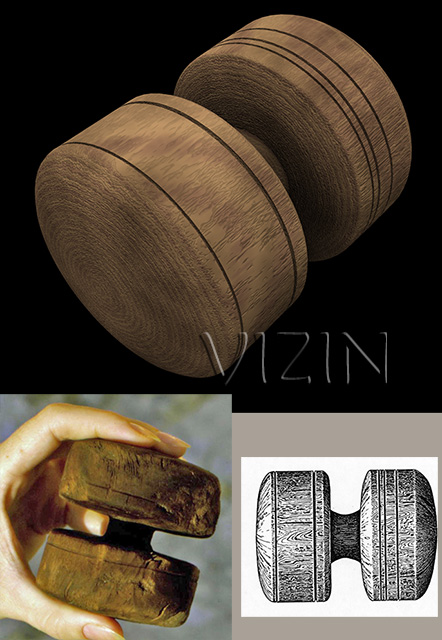 Over the years since this project began, the visualization software and online viewing environments have continued to change; sometimes for the best, sometimes not so much. Our team's initial interactive mode of choice, back in 2004, was VRML. All our object models and ship timbers and hull reconstruction models used VRML (for example, the model of the so-called 'yo-yos' or wooden toggles found all over the ship; see the rendering and images at the left; hover over to enlarge). More recently, VRML was no longer supported natively in browsers (nor as a plugin). We then switched to using the Unity game engine to show off the advantages of interactive virtual worlds for research, data analysis, hypothesis testing, and online publications. Unity worked quite well, especially for virtually re-diving the wrecksite, seeing the artifacts in situ and then allowing viewers to click on timbers or objects to retrieve relevant information about them from inside the virtual world. Such innovative methods of studying archaeological sites have always been a hallmark of Learning Sites. The Internet is a continually morphing beast, and now game engines are no longer viewable inside browsers. The WC3 Consortium has mandated that WebGL and HTML5.0 be the platform for building and viewing interactive virtual worlds online. Thus, we have rebuilt our models yet again to keep pace with technology and online expectations. Below is our latest version, focusing for now on select artifacts and features of the ship.
Over the years since this project began, the visualization software and online viewing environments have continued to change; sometimes for the best, sometimes not so much. Our team's initial interactive mode of choice, back in 2004, was VRML. All our object models and ship timbers and hull reconstruction models used VRML (for example, the model of the so-called 'yo-yos' or wooden toggles found all over the ship; see the rendering and images at the left; hover over to enlarge). More recently, VRML was no longer supported natively in browsers (nor as a plugin). We then switched to using the Unity game engine to show off the advantages of interactive virtual worlds for research, data analysis, hypothesis testing, and online publications. Unity worked quite well, especially for virtually re-diving the wrecksite, seeing the artifacts in situ and then allowing viewers to click on timbers or objects to retrieve relevant information about them from inside the virtual world. Such innovative methods of studying archaeological sites have always been a hallmark of Learning Sites. The Internet is a continually morphing beast, and now game engines are no longer viewable inside browsers. The WC3 Consortium has mandated that WebGL and HTML5.0 be the platform for building and viewing interactive virtual worlds online. Thus, we have rebuilt our models yet again to keep pace with technology and online expectations. Below is our latest version, focusing for now on select artifacts and features of the ship.
Navigation tips: The tabs at the top left toggle among the objects. The main left window contains the interactive virtual object model. Use the left mouse button and touchpad or mouse wheel to rotate the object; right click then mouse movement pans the model; just the mouse wheel or left edge of a touchpad zooms the model. The "open controls" button pulls down two sliders to move the drawing and to change the opacity of the drawing. The right window contains supplemental information about the object, which can be accessed by clicking on the tabs: "Specs." for detailed specifications for the object; "Desc." for a description of the object; and "Images" to bring up multiple photos and drawings of the object (click on the 'i' for further information about the image; click again to turn it off). Enjoy.
Katzev, Michael L.
1981 “The Reconstruction of the Kyrenia Ship, 1972-1975,” National Geographic Society Research Reports 13:315-328.
1974 “Cyprus Ship Discovery,” The Illustrated London News, Archaeology 2394:69-72.
Katzev, Michael L. & Susan W.
1989 “Kyrenia II: building a replica of an ancient Greek merchantman,” pp.163-175 in TROPIS I, Proceedings of the 1st Symposium on Ship Construction in Antiquity, Piraeus, 1985, Piraeus: Hellenic Institute for the Preservation of the Nautical Tradition.
1986 “Kyrenia II: research on an ancient shipwreck comes full circle in a full- scale replica,” INA Newsletter 13.3:2-11.
1974 “Last Harbor for the Oldest Ship,” National Geographic Magazine 146.5:618-625.
Steffy, J. Richard
1994 Wooden Ship Building and the Interpretation of Shipwrecks, College Station, Texas: Texas A&M University Press.
(see especially pp.42-59 and passim for details about the Kyrenia wreck)
Online resource: Kyrenia castle museum: http://www.cypnet.co.uk/ncyprus/city/kyrenia/castle/shipwreck/index.html